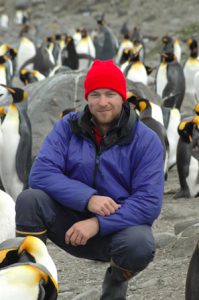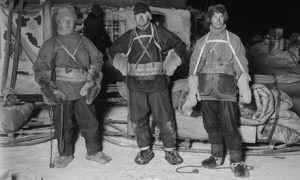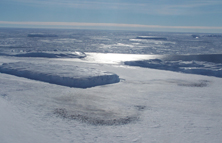 Name: Tom Hart
Name: Tom Hart
Role: Lecturer/Penguinologist
1st ALE Season: 2013
Nationality: UK
Penguinologist Tom Hart loves penguins and is working hard to develop conservation strategies for them. So when he got the opportunity to visit an emperor penguin (Aptenodytes forsteri) colony with ALE in 2013 he jumped at the chance. We caught up with Tom recently to ask him about that experience and about his ongoing research.
How did you get involved in this area of research? What was the attraction?
I begged and finally got accepted to undertake a PhD with the British Antarctic Survey (BAS) and Imperial College. I’m interested in ecology and conservation. Conservation of wildlife in general is a big problem. The thing that attracted me to Antarctic conservation is that the Antarctic Treaty offers a promising role model for global conservation. Under the Treaty, if one can demonstrate that a problem exists and show how to solve the problem, then something has to be done about it. The attraction was to work with fisheries and ecological management to make it more sustainable. However, I fell in love with penguins and the South and there was no going back.
Tell us a bit more about your research. What is Penguin Lifelines?
I’m doing large-scale research with two main areas of focus:
- Genetics. We are trying to work out the structure of penguin populations and how they move over time, in order to understand natural vs. unnatural changes.
- Use of time-lapse cameras to see breeding success over time. The cameras do the same work that an ecologist would do, but over a longer time period and with more frequent monitoring.
Penguin Lifelines is project at Oxford University. We are using long-term monitoring in the field and genetic analysis of penguin feathers to get a complete picture of how populations are changing; to identify threats to penguins all around the Southern Ocean; and to work out strategies to mitigate those threats.
How does genetic monitoring contribute to an understanding of the effects of climate change on penguin populations?
If we are going to understand current changes to penguin populations, we need first to understand historic changes, so that we have a baseline and context. Genetic monitoring allows us to track movement, so that we can see the historic population structure and how it has changed over time.
 In one of your papers you mention using historic samples?
In one of your papers you mention using historic samples?
We have been getting as many samples as we can; bits of penguin skins from the Natural History Museum and eggshell fragments from Scott’s hut. The samples are labeled and so we know where and when they were collected. All of the Scott and Shackleton samples and other giants from the heroic age of exploration are held there. There are samples collected and labeled by Bowers and Apsley Cherry-Gerrard (of the Worst Journey in the World). Not only do the data contribute to our understanding of historic populations, but it’s very cool to have such a direct connection to these great explorers.
What are the greatest challenges associated with your research? What do you love best?
Because I work on such a large scale, I need to monitor large numbers of penguins in many locations. Putting in place all of the required permits and logistics that allow me to work in the southern ocean and access remote locations is probably the greatest challenge. By the time I get to Antarctica, I love the simplicity that the ice brings –the most (and only) important things are food, warmth and shelter. It’s a simpler life with the most amazing backdrop on the planet.
I love the excitement of being underway. There is so much pre-trip planning and organization that it is a relief when the plane door closes and I can leave all of that behind. It’s great to get on the ice and focus on the research. It’s also very exciting on a personal and scientific level to visit these remote locations and to do science that hasn’t been done before.
How do tourism activities contribute to your work?
I’m a hitchhiker. I use ‘ships of opportunity’ – cruise ships, yachts or in the case of ALE, aircraft – to access remote penguin colonies. In return for transport and the opportunity to do science, I talk to the guests about penguins and my research, which enriches their experience. When you see a strange animal, it can be hard to interpret what is going on. I can provide insight into penguin behaviors and context for the experience.
How did you get involved with ALE?
I kept meeting [ALE owner] David Rootes at various Antarctic meetings. It took about two years of subtle suggestion and two years of not so subtle begging to be able to join an Emperor Penguins Experience! 🙂
You worked as a lecturer and penguin expert on ALE’s Emperor Penguin Experiences. What was that like?
 It was my first time travelling to the interior of the continent. Penguins live on coast, so most of what I do is take yachts and ships to colonies on the fringes of Antarctica. It was really exciting to see the different landscapes: to fly to the bleak interior of Antarctica, then continue on to the Weddell Sea coast, land in the middle of nowhere and see so many penguins. It was my first time at an emperor penguin colony. To be honest, it felt a little like cheating on macaronis. They are my favorite penguin species, but seeing the emperors I could understand what all the fuss is about. I was struck by the fact that we were seeing them at the ‘easiest’ time of the year. In late November, when we visited, they had already survived the winter and reproduced. To sum up – it was amazing.
It was my first time travelling to the interior of the continent. Penguins live on coast, so most of what I do is take yachts and ships to colonies on the fringes of Antarctica. It was really exciting to see the different landscapes: to fly to the bleak interior of Antarctica, then continue on to the Weddell Sea coast, land in the middle of nowhere and see so many penguins. It was my first time at an emperor penguin colony. To be honest, it felt a little like cheating on macaronis. They are my favorite penguin species, but seeing the emperors I could understand what all the fuss is about. I was struck by the fact that we were seeing them at the ‘easiest’ time of the year. In late November, when we visited, they had already survived the winter and reproduced. To sum up – it was amazing.
What can people expect at the emperor rookery?
It’s a real wilderness experience. The colony is impressive because of its isolation and the number of birds. There are lots of birds and lots of calling, day and night, which comes across as a real oasis of life in an otherwise deserted landscape. The nearest humans are at the Argentine station, Belgrano II, which is only slightly closer than the international space station!
What was the highlight of the trip?

There were so many amazing moments, but two in particular stand out.
- The first was seeing the first poo stain on the snow, when flying in to the emperor colony. You are flying over this vast expanse of ice and suddenly you see a pink poo stain on horizon and know that an emperor colony is there. As you get closer, it resolves into tiny dots and you get a sense of how many penguins must be there in this incredibly remote location.
- The second thing that stood out for me was seeing fossilized animal footprints from extinct Trilobites at Union Glacier. They were so out of place. It was striking to think about what Antarctica was like at the time they were created, to know that the footprints were laid down in a different era, on the shores of an ancient seabed and to compare that to the current icy landscape.
So penguin guano can be used to detect colonies?
Yes, in fact researchers used guano stains on satellite images of the coast to do the first complete count of emperor colonies in Antarctica.
Is there anything else you would like to share about the experience?
People go to poles to see snow and wildlife – but there is also a sense of camaraderie on Antarctic expeditions. I love how you meet incredibly interesting, passionate, bonkers and amazing people down there. When we were at Gould Bay, the Emperor Penguin Camp Manager was Hannah McKeand, who has skied to the South Pole six times.
How can people support your research?
If people would like to support my research then they can adopt a colony, which will help place a web camera that will be used to monitor the penguins with minimal disruption to their environment.
We also have a project called Penguin Watch, that enables people to click on penguins and help analyze the data that we are collecting.
Links
Read about Tom’s trip to Union Glacier and Gould Bay with ALE
ALE’s Emperor Penguins and Emperors & Explorers Experiences
Penguin Lifelines website – https://penguinlifelines.wordpress.com/
Penguin Watch – https://www.penguinwatch.org/